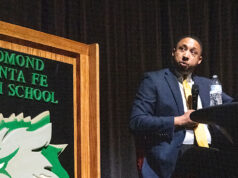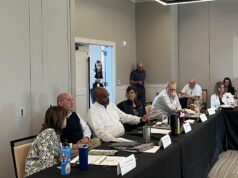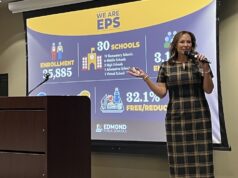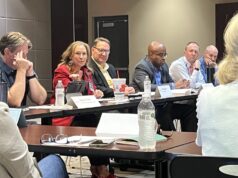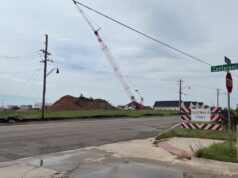![Indoor_Acquatic_and_Multi-Sport_Facility[1] bond propositions](https://nondoc.com/wp-content/uploads/2020/08/Indoor_Acquatic_and_Multi-Sport_Facility1-640x314.png)

Normanites have a lot on their plates these days. Controversy over police funding spawned an effort to recall Mayor Breea Clark and three city council members. The city’s mask ordinance stirred passions on both sides of the issue. And the police union sued the city.
On top of that, on Aug. 25, voters will decide the fate of GO Norman 2020, a slate of projects with a combined cost of $119 million.
There are four bond propositions on the ballot. The most expensive would authorize $85.6 million toward completion of Norman Forward projects approved by voters in 2015. Other propositions would tackle homelessness, remake the city’s municipal complex and provide assistance for local businesses affected by the COVID-19 pandemic.
“You may have heard there’s a lot going on in Norman,” Clark said. “But these projects shouldn’t be partisan issues. They’re good, common-sense investments in our community.”
Water sports, fire trucks and COVID-19
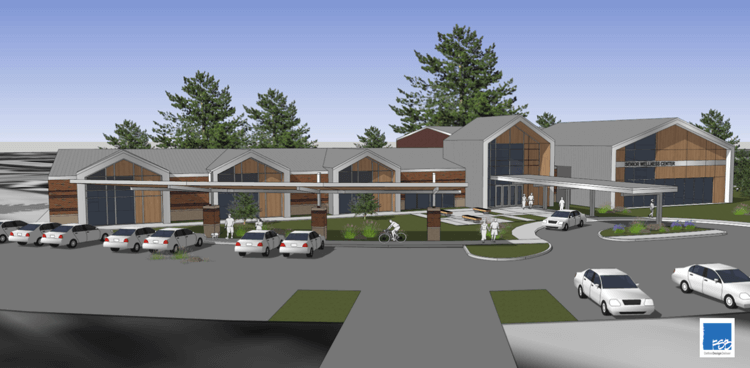
Voters will find four stand-alone propositions on their ballots and will decide the fate of each individually.
Proposition 1 ($85.6 million): The largest proposition includes $59.4 million for construction of a multi-sport and aquatic facility, $4.8 million for a 27,000 square foot senior wellness center, $9.1 million for a softball and football complex for youth sports, $7.4 million for new softball fields at Reaves Park, $2.8 million for a parks maintenance facility, $2.1 million for enhancements to Ruby Grant Park and $21.8 million for an indoor-outdoor soccer complex.
Proposition 2 ($5 million): Funds would go toward construction of additional housing for the city’s homeless population and programming designed to assist them.
Proposition 3 ($24.3 million): Projects include $8 million toward construction of a new operations and dispatch center for the city’s emergency services. A further $5 million would go toward construction of a fleet maintenance center for the city’s buses and fire trucks. The city’s municipal complex would also get an $11 million makeover.
Proposition 4 ($5 million): This proposition would provide assistance for local businesses impacted by the novel coronavirus pandemic through the creation of a small-business relief fund with emphasis on job retention and marginalized communities.
No time like the present
With millions of Americans still unemployed and a 32 percent contraction in GDP in the second quarter, it may not seem like a great time to ask voters for more money. The mayor, however, believes there’s no time like the present to move forward with the projects.
“How do you ask for money in a pandemic is a question some people have,” Clark said. “But the question is when will taxpayers feel it? It won’t be until 2022. The great thing is if we pass this now, we can immediately move forward with construction. It’s really a perfect time.”
Unlike past city projects that relied on sales tax receipts, citizens would pay for GO Norman 2020 through increased property taxes. According to estimates from the City of Norman, approval of the four propositions would cost someone who owns a $150,000 home in the city about $14 more per month in property tax.
Multi-sport facility a big ask
The multi-sport facility is by far the most expensive item on the slate, at nearly $60 million. It would include aquatic facilities big enough to host state tournaments, something the city can’t do now.
The Murray Case Sells Swim Complex at the University of Oklahoma is the largest swimming facility in Norman, but it’s also nearly 50 years old. Clark sees economic opportunity in a complex that can host events.
“There are a lot of great projects included and one is the idea of an aquatics center,” Clark said. “Aquatics are expensive not just for residents to use but also to maintain. OU has a facility that is older and has had maintenance problems, and outside of that there’s really only Westwood. It really doesn’t make sense to keep pumping money into those facilities. We need to do everything we can to increase tourism, and a new facility would help bring events to Norman.”
Are these projects worth the money?
The “build it and they will come” theory of municipal projects holds that if a community has state-of-the-art facilities for sports and entertainment, visitors will be more likely to spend time there.
But does it work that way? University of Oklahoma economics professor Cynthia Rogers says not always.
“I think that’s mostly a sales pitch,” Rogers said. “The way you know it’s a sales pitch is they say we can generate revenue, and they never talk about the cost. They never say what kind of extra revenue would be needed to pay for a $60 million project. And if you’re running this to generate revenue, those 30 tournaments a year are 30 weekends that people in the community can’t use the facility, which is what it’s for.”
Rogers said estimates of the positive financial impact of facilities such as an aquatics center are often overstated. Neither the City of Norman nor the Norman Chamber of Commerce has offered potential revenue projections.
“It’s a nice narrative that these will bring in millions of dollars in revenue, but there’s no substantive research behind it,” Rogers said. “Cities often bring in companies that will do studies, but what they’re really doing are marketing reports. They have crazy projections, but they really never look at actual revenue. These reports are poor when it comes to predicting results accurately.”
The ethics of aquatics
One of the selling points for voters on the multi-sport center is the local community’s ability to use it. But, often, some people are priced out of the fun.
Projects such as the Chesapeake Energy Arena have been paid for by Oklahoma City taxpayers, but not everyone can afford to enter its doors for concerts and Thunder games. Those who would use the proposed multi-sport center in Norman would be required to pay for the privilege.
“I’m just not a fan of projects like that,” OU philosophy professor Stephen Ellis said of the multi-sport center. “I’m not comfortable with the distribution. It seems like it’s taking money from everyone and pushing it up the income scale. Given who will actually benefit from the project, that’s my big issue with it.”
Ellis, who is married to Rogers, said that conflict is not uncommon with big city projects that are sold as revenue generators.
“There’s a tension between having facilities that are truly for the community and those who are intended to make money,” he said. “If we are going to have facilities for the community, I think we should be focusing on things all over town, making sure they’re accessible to everyone.”
Municipal complex improvements sought
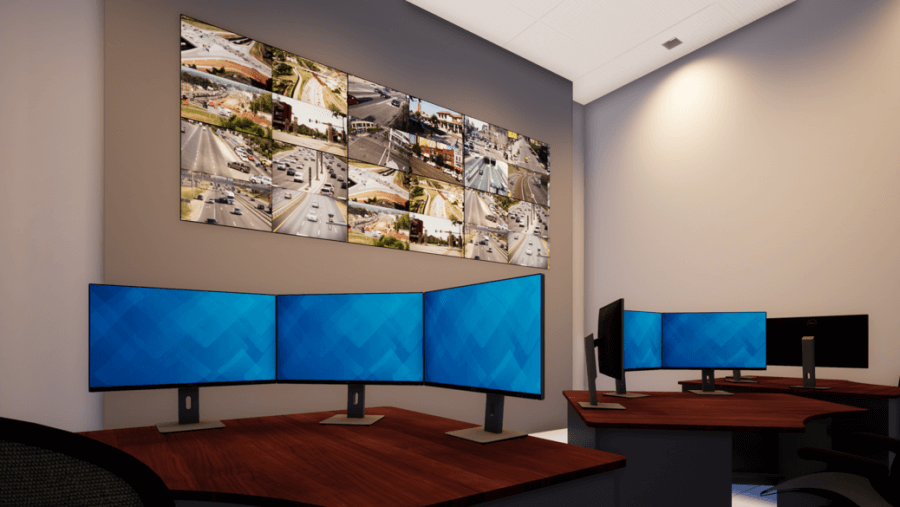
The more than $24 million that would be dedicated to revamping the city’s municipal complex includes funds to construct a new emergency operations and dispatch center. Currently, that facility is inside the police station.
“They’re literally operating out of a basement,” Clark said. “It’s very crowded, and the working conditions are not great. If a severe weather event like a tornado or a train crash took out our police station, it would also take out our operations center. This is a much needed piece.”
Another part of the project would provide citizens a one-stop shop for things like business and sales tax permits, among other services. Currently those services are housed in separate buildings.
“This will centralize things and make it more business and development friendly,” Clark said. “If you have to get a permit, you’ll know that’s the building you need to go to.”
Business assistance program still waiting on specifics
Like Oklahoma City, Norman’s city government is looking for way to assist local businesses impacted by the novel coronavirus pandemic.
A $5 million proposition would do just that, but some of the details have yet to be worked out. Clark said she would like it to be aimed at marginalized communities and businesses that don’t qualify for federal assistance.
“Right now, our Economic Development Advisory Board is working on looking at businesses that fall into those loopholes and specifically what is needed,” Clark said.
Some of the funds would be used for job retention and creation programs, according to the city’s website.
Rogers, who also serves on the Oklahoma Incentive Evaluation Commission, said those programs can be effective, but the devil is in the details.
“I think the important thing is to know how this money is used and how it is targeted,” she said. “It’s not a lot of money. It’s a small pot. But, ‘We’ll just figure it out,’ I don’t know what that will mean. These types of programs can work, but it’s critical that they be clearly defined and get to the right businesses if they are to be useful.”









